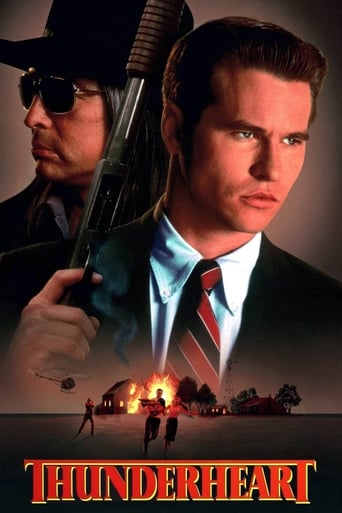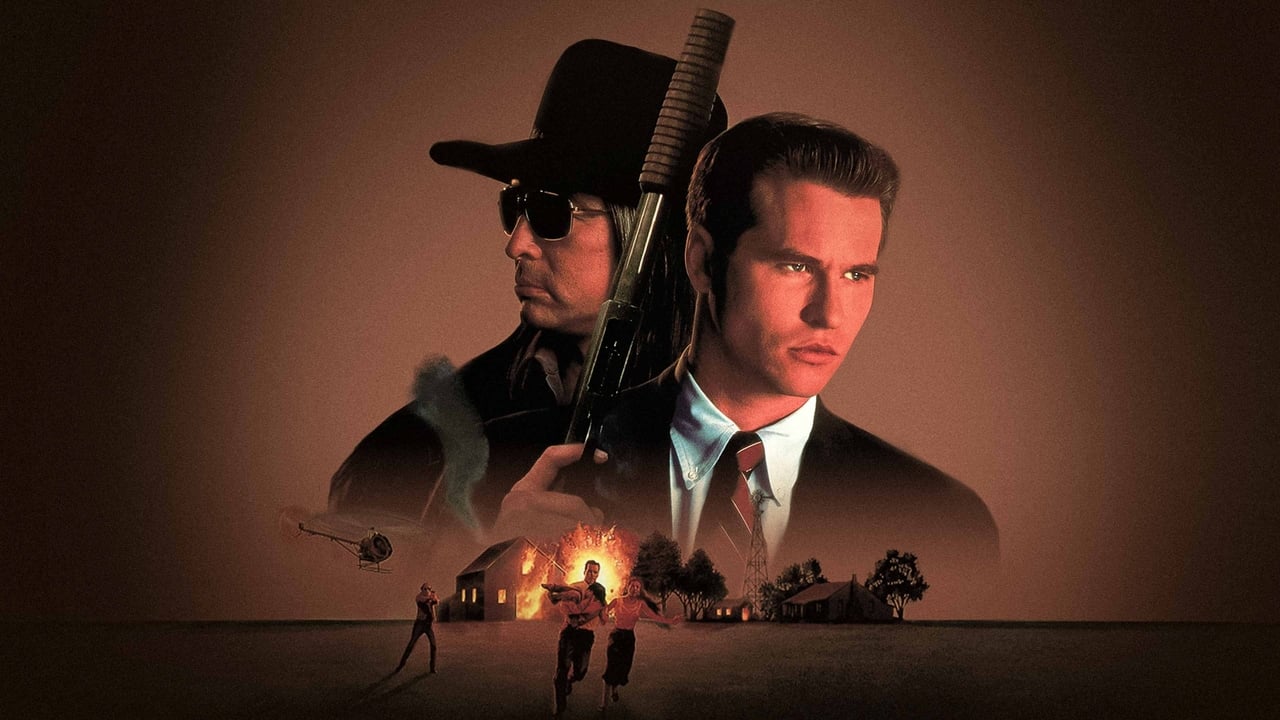Predrag
A very under-rated film from way-back. This film continues to illustrate the historic, persecution of a part of America's native heritage, and sets a scene of greed and exploitation on an Indian reservation. In the film, influenced by events that took place in the seventies, Val Kilmer (Ray Levoi) convincingly plays the part of an FBI agent, whose part-Sioux background makes him the prime choice to investigate a death on this Indian reservation. Teamed up with an infamous, older agent, played by Sam Shepard, the investigation leads Kilmer to the realisation that the U.S. government has framed an innocent man. This movie was very well done and gave examples of how the Indian culture really is and Graham Green played a very important part in educating us. Greene is one of my favorite Native American Indian actors. He is from the Six Nations Reservation tribe in Canada.The arid location, the Indian actors, and the haunting music of James Horner, easily takes hold of the imagination; transporting one back to the time when a culture viewed the inquisitive, intrepid explorers of old with suspicion. The intriguing Chief Ted Thin Elk, the reservation's religious leader, knows the secret of Levoi's (Kilmer) lost heritage. Wisdom emanates from this old Indian, but as the leader of a defeated people, he looks to Levoi, and sees in him the spirit of the historic 'Thunderheart'. During a touching sequence in the film, the Chief tells Levoi that he is their modern- day 'Thunderheart' and that he must make for the 'Stronghold' the historic Thunderheart was unable to reach. As the film draws to a close, Levoi finds the evidence he needs to expose the plot, despite Shepard's efforts in eliminating the witnesses. Pursued by Shepard and his henchmen, Levoi makes for the ancient, mountainous stronghold. There above him in the mountains, when all seems lost, he finds the support the old chief said would be there. This film is a must for those who can sense the legacy left to us by one of the world's deeply spiritual, nomadic nations.Overall rating: 9 out of 10.
gimili
Ray Lavoy is a part American Indian FBI agent assigned to work at the Bear Creek Indian Reservation in South Dakota to help diffuse tensions between "traditional" Indians and "pro-government" Indians. He works with another longtime legendary agent named Frank Coutelle. A murder of a tribal member who was a pro-government American Indian has turned the reservation into a hot zone of unrest. At first Lavoy works along government lines with Coutelle and follows protocol in trying to solve the murder. But along the way he begins to discover that not everything is what it seems, with the investigation, and with his American Indian ancestry. Throughout the investigation a local police chief named Walter Crow Horse(Graham Greene) tries to convince Lavoy that his murder investigation of a particular suspect is wrong and that he needs to rely on his American Indian roots to help him find the way.What I admired most about this movie was the scenery and how the movie used a fictional murder investigation to portray and try to tell the story of the real life American Indian Movement of the 1970's. If you know anything about AIM(American Indian Movement), you will constantly find yourself thinking during this film, "That character is based on....from AIM." In the movie, the traditional group is called ARM(Aboriginal Rights Movement). In the movie the fictional Bear Creek reservation looks to me like Pine Ridge reservation in Pine Ridge, SD.There were only two aspects of the film I did not enjoy. First was trying to understand the time frame, whether it was present day or sometime before. I got the impression the film was present day 1992, but because of all the history you start to think it is the 1970's. Second, the portrayal of FBI was a little over the top. Other than Ray Lavoy, the rest of the agents were portrayed as individuals who disrespect and mock American Indians and American Indian tradition. I imagine this was to help single out FBI agent Lavoy and how he struggles to understand American Indian culture.This is a great old film with a soundtrack that really makes the viewer feel like they are tied to the spiritual connection of the sacred land portrayed in the film. Solid acting, solid soundtrack, and solid plot make this a movie worth seeing.
Gregg Wager
After reading some of the reviews posted here of Thunderheart, I am happy to see so many are positive. A few have posted the type of negative review I might have expected more of, that is, that the movie falsely criticizes the American Government of malfeasance and fraud.After seeing Thunderheart several times, I recognize many of the most controversial American Indian issues that have been interwoven into this parable that is set in South Dakota. It might be of interest to those who enjoy this movie exactly what those events were.ARM—Thunderheart centers around an activist Native American movement based on the real organization called AIM (American Indian Movement). President Richard Nixon was genuinely angry when AIM marched onto Washington in 1972 and forcefully, but without any injuries, occupied the Bureau of Indian Affairs. They were led by charismatic leaders such as Dennis Banks and Russell Means, and although their protests were not typically violent, Nixon made sure that they were treated like any other radical and violent organization of that era.GOONs—Fred Ward plays the character "Jack Milton," who is based on the Tribal Counsel President of the Pine Ridge Reservation, Dick Wilson (1934-1990). The name of his private police force, Guardians of the Oglala Nation (or GOONs) was apparently too good to change for the film. The violent acts by GOONs depicted in the film—roadblocks, shootings, and the secret murders of Wilson's political enemies—are all based on true events, for which Wilson was impeached in 1973, although reelected again in 1974. It is also mentioned in the film that GOONs was financed by misdirected money that was intended for humanitarian purposes on the reservation.Bear Creek Indian Reservation—This is a pseudonym for the Pine Ridge Indian Reservation.Two dead agents, "family men"—At one point, Cooch mentions two FBI agents who were killed. This is based on agents Ronald A. Williams and Jack R. Coler, who were killed by multiple gunshot wounds on June 26, 1975. A detailed depiction of this shootout, along with the story of Leonard Peltier, who was ultimately convicted of the double murder, is in Peter Matthiessen's book, In the Spirit of Crazy Horse.Jimmy Looks Twice—Ray asks Cooch if the mission they're on is a "mop up," in other words, he suspects that Cooch is just trying to pin the killing on anyone, just to close the matter for good. Peltier was charged along with three other AIM members in the brutal slaying of Agents Williams and Coler (only Peltier was eventually convicted and is still serving a life sentence). As explained in Matthiessen, the controversy surrounds the way the two agents were first wounded by gunshots from afar, and then "finished off" at close range. The case against Peltier and three other AIM members appears to be nothing more than the FBI railroading some of the more visible activists. Nonetheless, efforts to get Peltier a new trial or possibly even a pardon (as was imminent at the end of Clinton's Presidency) have been unsuccessful. Jimmy is played by John Trudell, a longstanding activist in AIM.Maggie Eagle Bear—Cooch scolds Ray by saying, "Now ARM people think she's an informant." Maggie is undoubtedly based on Anna Mae Pictou Aquash (1945-1975), who was a Micmac Indian (not Sioux) and never attended Dartmouth as Maggie did, but was a mother and AIM activist who was murdered under still mysterious circumstances. Cooch infers one of the theories, that AIM members killed her for being an FBI informant. Matthiessen suggests a scenario more akin to the movie, in which FBI agents might have even dragged their feet to identify her. The film also adds a second layer as a motive for the murder involving uranium mining which was contaminating the water.Richard Yellow Hawk—An agent provocateur in a wheelchair, Richard adds yet another layer to the plot, in that the FBI was planting its own agents into activist organizations like AIM to gather information and discredit them. Although the FBI program COINTELPRO was discontinued in 1971, parts of it did continue into the 1970s to monitor AIM.Red Deer Table—The issue of contaminated water due to uranium mining, or of strip-mining in general, is most prominent not on the Pine Ridge Reservation, but on the Hopi Reservation in Arizona. The mining companies, with the help of the Federal Government, invented a Navajo-Hopi Land Dispute, in order to move Navajo off of coal-enriched land so they could strip-mine it. That Cooch is motivated by the land deal adds this geographically remote Indian issue to this tale.Thunderheart—Although there are 146 people buried at Wounded Knee, history records that over 300 Lakota men, women and children were killed there on December 29, 1890 (as Grandpa Sam Reaches explains to Ray). The famous Sioux chief Sitting Bull was killed 14 days earlier. When Ray visits the Wounded Knee Monument, he reads "19. Thunderheart," the name of the Indian he is supposed to be the reincarnation of, as the 19th name listed in the mass grave. Actually, the 19th name on the monument, according to some photos on the Internet, is an Indian named Swift Bird.Above all, this film does not claim to be nonfiction. The opening disclaimer says: "This story was inspired by events that took place on several American Indian reservations during the 1970s." Recently, there has been a strong effort from the politically right to show that Peltier really was the close-range executioner of the two FBI agents and that Acquash was murdered by AIM members because she knew this. Although this bizarre version of events has all the twisted logic of Barack Obama's Kenyan birth certificate, it is being employed in a new trial against two AIM activists, John Graham and Richard Marshall. A third, homeless man, Fritz Arlo Looking Cloud, has already been convicted in 2004 for the murder of Acquash, and his strange testimony is being used against Graham and Marshall.
drystyx
I recall that even when the movie was made, it was a hodge podge of every contrived and stereotypical movie scene acceptable, taking absolutely no chances. It is supposed to be an action think piece, but fails on all counts. The action is slow, which isn't as bad as the plot being predictable to every detail. It would be nice if the movie just took one bit of risk, but this is about as risk free as you can get. A movie that takes no chances. It just puts together every mundane acceptable situation in films. One gets the feeling that the team making this film just threw in some dialog and said "Lets make a movie". Total lack of originality and total lack of inspiration. Total bomb.



 AD
AD


